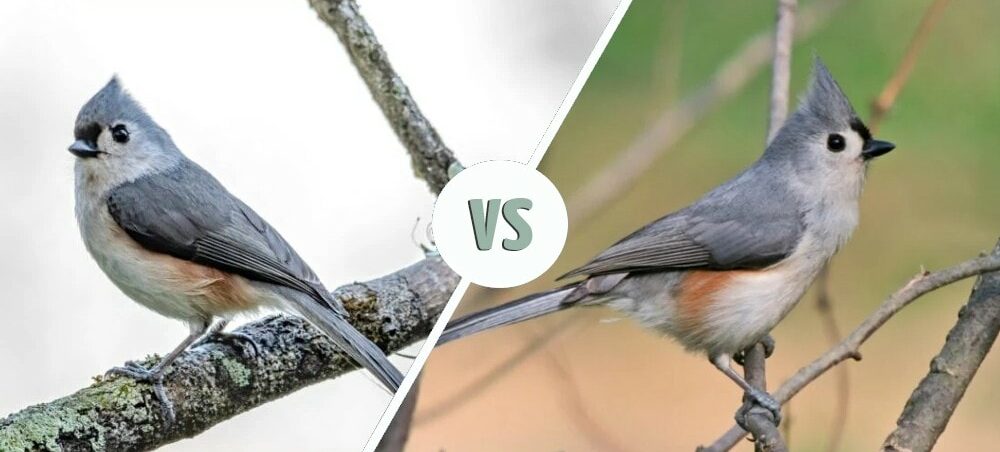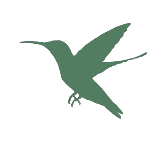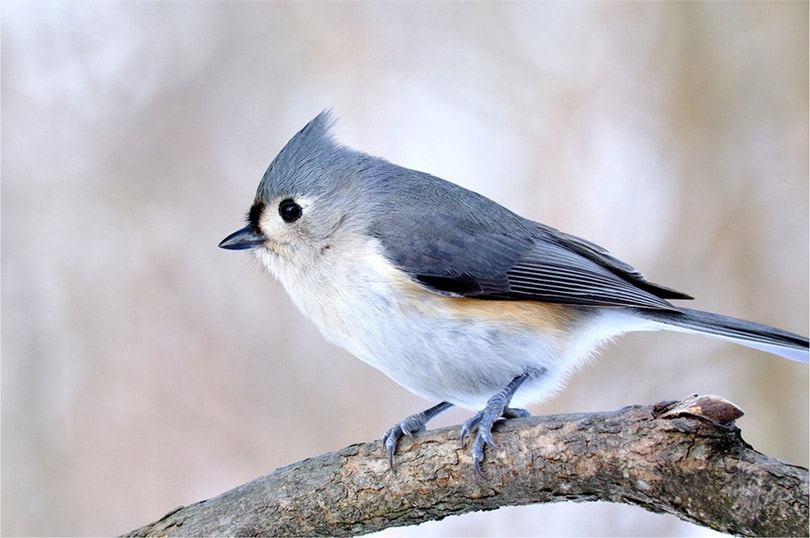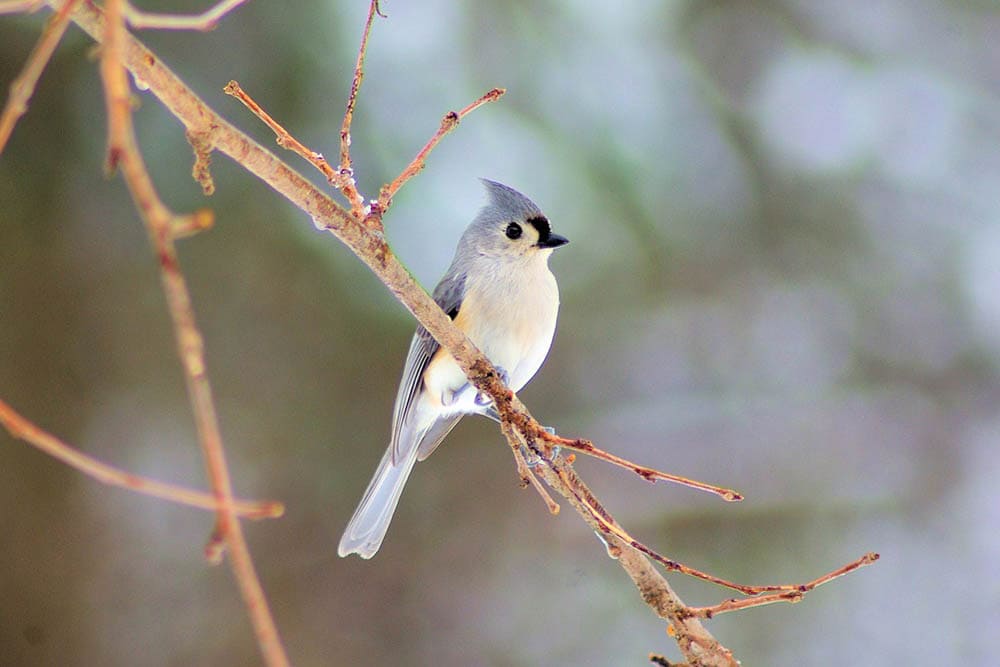Male vs Female Tufted Titmouse: How To Tell The Difference? (With Pictures)
Last Updated on

Tufted Titmice are gorgeous birds with large, tufted heads and stunning silvery-white plumage. When observing the male and the female Tufted Titmouse, it is hard and almost impossible to see any difference. These two genders are virtually identical, making it challenging to differentiate them. The only time when gender differences may occur is when expressing particular social behavior.
If you want to learn how to tell these two genders apart, read this article, which thoroughly explains the patterns of their behavior and why females or males may act a certain way.

Visual Differences

At a Glance
- Average size: 5–6.3 inches
- Average life span: 2 years
- Average wingspan: 3.14 inches
- Behavior: More dominant, territorial
- Songs and calls: Fast, clear, repeated whistle
- Average size: 5–6.3 inches
- Average life span: 2 years
- Average wingspan: 3.14 inches
- Behavior: More dominant, territorial
- Songs and calls: Fast, clear, repeated whistle

Tufted Titmouse 101

The \ is a lovely small songbird native mostly to eastern North America. Due to warm climates, it enjoys the habitat of southern North America, although its range has been shifting more to the north since the start of the 20th century. This interesting bird is common in backyard birdfeeders, usually moving in groups with other species.
The male and the female Tufted Titmouse look almost identical—with a soft, creamy gray plumage, black wings, and peachy undertones. Their name comes from the tuft of feathers that point out on the back of their heads. They have a large head and eyes and a thick neck, which makes this bird easily recognizable in the bunch. Even though these two genders are visually identical, there are vast behavioral differences and feeding and nesting habits.

Male Tufted Titmouse Overview
Personality / Character
Male Tufted Titmice tend to show a more dominant behavior, particularly when it comes to defending their territory from other birds. They are more likely to chase other species of birds away. When it comes to the songs and calls a male Tufted Titmouse make, they are fast, repetitive, and echoing through the woodlands. They sing a distinctive ‘’peter-peter’’ song. Their calls have sharp, almost mechanical sounds. They use these scratchy calls to warn other birds of potential predators.

Training
Tufted Titmice are very common in backyard birdfeeders, both males and females. Although they have a short memory, they can be trained in minor activities such as feeding from a hand. They feed on berries and seeds, so if you manage to train a Tufted Titmouse, you might be able to get it to feed directly from your hand instead of from the feeder.
Nesting / Feeding
Once the female lays eggs and begins the incubation process, the male will provide the female with food throughout this entire period. Even after the eggs hatch, the male bird will continue collecting food for the female bird and its young. The female Tufted Titmouse will then begin to share this responsibility with the male.
- Protective of the female and the young
- It has an echoing, loud song
- Gatherer and provider of food
- Can be aggressive and territorial
- Non-tolerant of other birds nearby

Female Tufted Titmouse Overview
Personality / Character
The female Tufted Titmouse is much more tolerant than the male, especially regarding other bird species. When a fight between the Tufted Titmouse and other bird species occurs, the females are not likely to participate since the males are the main territory defenders. Female Tufted Titmice only show aggression around birdfeeders and when their young are in danger.

Training
Female Tufted Titmice are the same as males when it comes to training. They can easily be trained to follow the sound of the human voice and feed from their hands, although they are not as confident and as bold as other bird species that you may see next to birdfeeders.
Nesting / Feeding
The females are the only ones that stay in the nest during incubation. This period lasts from 12 to 14 days. During this period, the female depends on the male to provide food. On average, the females will take short breaks every 25 minutes to bathe, receive the food, and defecate. After the eggs hatch, the females will brood the nestlings without leaving the nest for the first few days. After 12 to 13 days, the females cut back on brooding and begin to help the males in gathering food.
- Tolerant of other birds nearby
- Protective of their nests and young
- It has a quiet, low-pitched call
- Dependent on the male for providing food

Interesting Facts About the Tufted Titmouse
- The oldest recorded Tufted Titmouse was 13 years old, which is incredible given that their average lifespan is only 2 years.
- When nesting, these birds tend to pluck hair and fur off animals directly to create the lining of their nest. Researchers have found hair from various animals, such as raccoons, dogs, cats, squirrels, and even humans.
- These birds usually pick the largest seeds and use their feet to hold them down and break them open with their beaks.
- You can call out a Tufted Titmouse by imitating its distinctive ‘’peter-peter’’ song.
- The Tufted Titmouse tends to store food for fall and winter, even though they have short memories of their hiding spots.
- The Tufted Titmouse prefers to nest in cavities, although they cannot create them independently. Instead, they search for natural holes and old nests that woodpeckers previously used.


Conclusion
Male and female Tufted Titmice exhibit different behaviors when nesting, feeding, and calling. If you observe these birds frequently, you can catch their behavior and recognize their particular gender. Try putting up a birdfeeder in your background; once you manage to attract these lovely birds, you will discover their differences shortly after.
The differences between these two genders will mostly appear during the nesting period. The males are responsible for gathering food for the females and the young, making the female birds entirely dependent. During this period, they will mostly stay inside the nest, protecting their young, while making short breaks for bathing, receiving the collected food, and defecating. The males act as a more responsible gender; they are also much more territorial, with tendencies to defend themselves from potential danger and other bird species.
While male and female Tufted Titmice have identical appearances, some behavioral differences may help you recognize the specific gender. If you have a bird feeder in your garden and are cautious enough, you may see how they behave with each other and with other nearby birds.
Featured image credit: (L) Karyn Honor, Shutterstock, (R) perching_Doug Lemke, Shutterstock
About the Author Robert Sparks
Robert’s obsession with all things optical started early in life, when his optician father would bring home prototypes for Robert to play with. Nowadays, Robert is dedicated to helping others find the right optics for their needs. His hobbies include astronomy, astrophysics, and model building. Originally from Newark, NJ, he resides in Santa Fe, New Mexico, where the nighttime skies are filled with glittering stars.
Related Articles:
How to Collimate Binoculars: 9 Expert Tips
How to Clean a Refractor Telescope: Step-by-Step Guide
How to Clean a Telescope Eyepiece: Step-by-Step Guide
How to Clean a Rifle Scope: 8 Expert Tips
Monocular vs Telescope: Differences Explained (With Pictures)
Can You Use Binoculars to Look At Stars? How to Choose the Right Pair
How to Choose Binoculars for Bird Watching: 10 Expert Tips
What Is a Monocular Used For? 8 Common Functions
